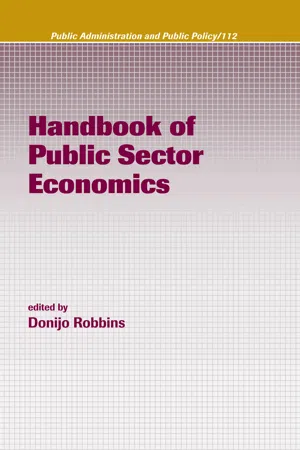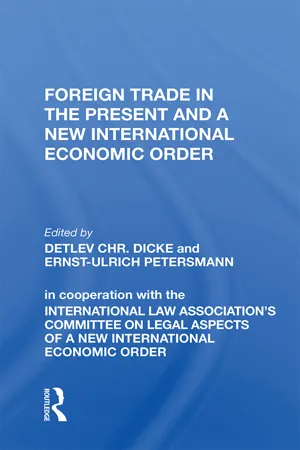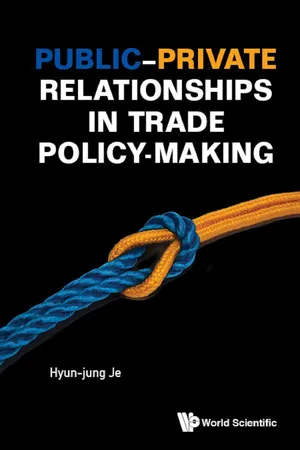Economics
International Trade and Public Policy
International trade and public policy refers to the government's role in regulating and promoting trade between countries. It encompasses policies related to tariffs, quotas, subsidies, and trade agreements, and aims to balance the interests of domestic industries, consumers, and the overall economy. The goal is to create a framework that facilitates efficient and fair international trade while addressing potential negative impacts.
Written by Perlego with AI-assistance
Related key terms
5 Key excerpts on "International Trade and Public Policy"
- eBook - ePub
- Donijo Robbins(Author)
- 2017(Publication Date)
- Routledge(Publisher)
In mainstream economic models, trade takes place in a political vacuum between nameless “homo-economicos” actors that do not carry a national flag. When the flag is included in the analysis, however, there are implications for trade theory and policy. The global system is, and will continue to be for the foreseeable future, built from states. States compete with one another. Of course, not all states compete as intensely as others do. Some even compete over world political-economic leadership. Despite this reality, many economists believe that trade politics mainly involves conflicts of interests within, rather than between countries. This view basically assumes that the lawyer–secretary trade, and international trade, are governed by the same forces. But, is this necessarily so? The answer is “it depends.” Trade between Belgium and Denmark is one thing. Trade between the U.S. and China or trade between the Israelis and Palestinians is a different thing, because these cases involve forces generally ignored in economics: political rivalry and conflict. Thus, international trade needs to be analyzed from a broader perspective that considers economic goals, foreign policy goals, and the effect of trade on political relations.17.8.1 Trade Policy Is Foreign Policy
Trade policy is at times a reflection of foreign policy. The use of trade in this manner has been prevalent since the time of ancient Greece. The idea was further developed during the 17th and 18th centuries when mercantilism examined the use of international economic policies as instruments in the service of a state’s larger foreign policy interests.The contemporary discussion is framed in terms of trade interdependence, trade dependence, and influence. When two countries trade, each country is sensitive to, or is affected by, the economic policies of the other. However, the extent of their sensitivity may differ. As such, trade interdependence can provide possibilities to influence other nations politically. The term trade dependence denotes asymmetric trade interdependence — a situation that arises when one trade partner needs the benefits of trade more than its partner does. Since both partners gain economically from trade, both lose economically when their trade ends. But the partner that values the gains from trade more is more vulnerable to the interruption. For example, one partner may not have readily available substitutes for import or may not be able to export to other destinations. - eBook - ePub
- W. Charles Sawyer, Richard L. Sprinkle(Authors)
- 2020(Publication Date)
- Routledge(Publisher)
9 , we examined the effects of tariff and nontariff barriers to trade and discussed how protectionism tends to make a country as a whole worse off. However, these effects are not uniform. The gains to consumers tend to be widely dispersed and in many cases hardly noticeable. However, the losses to domestic producers and workers are very concentrated. As a result, some firms and workers might seek protection from the government. In this chapter, we will explain why most countries provide protection to some domestic industries. We begin by analyzing the political economy of protection. Protection from imports may not be in the country’s best interest, but it is in the interest of selected special interest groups. We also explain a country’s structure of protection by describing why the tariff is high for some goods and low for others. Next, we explain what is known as administered protection as it has become difficult for governments to explicitly raise tariffs. These bureaucratic mechanisms have been developed that allow tariffs to be increased in the presence of allegedly unfair foreign competition.The second part of the chapter presents the evolution of U.S. trade policy from 1792 to today. The nature and fundamental principles of U.S. trade law are much easier to understand if you know something about its historical roots. The last section of the chapter describes the evolution of the global trading system since World War II. The WTO is the product of nearly fifty years of international trade negotiations. This section discusses the history of those negotiations, the troubled state of world trade negotiations and the issues left to be negotiated. A final section covers the current challenges to the current arrangement of international trade relations.THE POLITICAL ECONOMY OF PROTECTIONISMGiven that a country as a whole gains from trade, one would expect free trade to dominate most countries’ international trade policy. Trade barriers cost the economy more in lost consumer surplus than is gained by producers and the government. However, as we saw in the last two chapters, firms and workers in import-competing industries gain from trade barriers. As we will see in what follows, the interaction between the gains from trade for the country and the gains from trade barriers for producers explains the existence of trade barriers. The result is that free trade is not most countries’ international trade policy.In economics, policy refers to an action or actions that a government implements. For example, governments regulate industries and firms in a number of areas. These regulations are designed to modify economic activity in some way. In the presence of market failures, government regulation can improve the welfare of society. Such regulations are commonly observed for pollution or in the food and pharmaceutical industries. Not all government regulation of industries and firms works to the benefit of society as a whole; some regulations favor one segment of society. Industries and firms that benefit from regulation favor it.1 For example, it is illegal for firms to conspire to fix or raise prices. However, firms can legally raise prices if the government regulates and enforces minimum prices for an industry’s product. In this case, firms in this industry may find it in their own interest to accept regulation if it can enhance their profitability.2 - eBook - ePub
- John J. Kirton(Author)
- 2017(Publication Date)
- Routledge(Publisher)
Part IIISocietal and State Causes of International Trade Policy and RegimesPassage contains an image
[7]
THE POLITICAL ECONOMY OF INTERNATIONAL TRADE Enduring Puzzles and an Agenda for Inquiry JAMES E. ALT JEFFRY FRIEDEN Harvard University Michael J. Gelligan New York University Dani Rodrik Harvard University Ronald Rogowski University of California, Los AngelesA similar set of concepts has been central to the literatures on the formation of trade policy coalitions and the “new economics of institutions”: the political and economic consequences of the degree to which assets are specific to a particular economic activity. In this survey, the authors take the necessary first step of summarizing the main findings of these two literatures and then suggest ways in which the issue might be joined. In addition to providing a more coherent understanding of the findings of these two literatures and some new directions for them, the authors show that many puzzles remain in the field of trade politics—puzzles for which there are no appealing answers or, where there are answers, no strong evidence in support of them. This essay, then, in addition to being a theoretical review of the literature, puts forward an agenda for future study of international trade politics.I. Introduction
Over the past decade, the tools of modem political economy have been brought to bear on a wide variety of topics. Two active areas of work have been the politics of trade policy (endogenous tariff theory) and the new economics of institutions. A similar set of concepts has been central to both research agendas: the political and economic consequences of the degree to which assets are specific to a particular economic activity. There has been little or no attempt to explore this overlap. In this survey, we take the necessary first step of summarizing the main findings of these two literatures and then suggest ways in which the issue might be joined. In addition to providing a more coherent understanding of the findings of these two literatures and some new directions for them, we show that many puzzles remain in the field of trade politics—puzzles for which there are no appealing answers or, where there are answers, no strong evidence in support of them. This essay, then, in addition to being a theoretical review of the literature, puts forward an agenda for future study of international trade politics. - Detlev CHR. Dicke(Author)
- 2019(Publication Date)
- Routledge(Publisher)
Foreign Trade Policy and the Function of Rules for Trade Policy MakingHeinz Hauser *1. The Pursuit of National Welfare and International Order
The "Function of Rules for Trade Policy Making" is best discussed if we start with the observation that national governments negotiate international trade agreements. The motives of national governments for entering into and adhering to internationally agreed commitments and obligations are accordingly at the centre of any analysis of the relationship between foreign trade policy and foreign trade law.Why do we need international agreements on trade policy issues? The answer to this question seems so obvious that few have given it much thought.1 Trade policy has repercussions on other countries and international order is needed to foster the flow of goods and services across borders. Order is a precondition for international specialization of production and an important source of welfare and growth.I do not question the need for international order, but the conclusion that international agreements are necessary to protect international order does not follow automatically.Consider the case of a two-country world, where each country can either adopt a liberal or a protectionist trade policy stance. There is a broad consensus among economists that on purely welfare terms the following ranking applies in most cases, with a few exceptions which I will discuss shortly: welfare for any one country is highest if both countries adopt liberal trade policies, and it is lowest if both countries opt for a protectionist stance. The ranking for the other two alternatives of this 2x2 matrix is not so clear. Let me take a protectionist bias and assume that it is better for a country to have a protectionist policy combined with a liberal trade policy of the partner country than vice versa.If we apply this ranking to both countries, we get the pay-off matrix of table 1 , with the left entry for country A and the right entry for country B. The main conclusion one can draw from this exercise is far reaching: based on standard economic reasoning about welfare effects of trade policies, a liberal international trade order should develop spontaneously, without any need for co-ordinating agreements.2 Liberalization is the dominant strategy for both countries, regardless of what the other country does. Take country A as an example: if country B adopts a liberal trade policy, it pays for country A to opt for liberal trade policies too (B is better than SB). If country B takes a protectionist policy stance, country A is clearly worse off, but within this restriction it still pays to opt for a liberal trade policy and adjust to (biased) world market opportunities (TB is better than W). It is a rational policy for country A to choose a liberal trade policy stance even if it does not know the reaction of country B. The same line of reasoning applies for country B. Regardless of what country A does, a liberal trade policy is the rational response. Given the pay-off structure of table 1 , a liberal trade order is the spontaneous result of uncoordinated policy actions of national governments. Protectionist measures distort domestic relative prices compared to world market opportunities, reduce flexibility to adjustment, and are a burden for competitive industries. Protectionism hurts not only foreign producers but also the country that introduces distorting policies.3- Hyun-jung Je(Author)
- 2018(Publication Date)
- WSPC(Publisher)
In this regard, Dymond and Hart have stated that trade policy was included in ‘low’ politics, which was the realm of technical issues rather than political ones mainly because “the Cold War ensured that peace and security would be the crux of high policy and the main determinant of relations among States.” 14 Likewise, trade policymaking was regarded as a monopolized area for nation-states and in the hands of government officials for quite a long time, but the environment of trade policy began to change and has rapidly transformed since the 1990s, as illustrated in Figure 1. Figure 1: Changing Environment of Trade Policy-making Source: Summarized by author. Before discussing the analytical framework on the public–private relationships in trade policy-making processes, it is necessary to begin with an overview of how the environment of trade policy has been changing and how these changes have affected public–private relationships in trade policy-making. The changes summarized in Figure 1 will be explained more in detail. 1.1 Expansion of Trade in Volume and Agenda The first reason for transformation of the trade policy environment was change in trade itself. After World War II and the ensuing independence of colonies, more countries became increasingly dependent on trade and many countries, mostly Asian countries, adopted trade-oriented economic development plans. The ratio of trade to GDP (Gross Domestic Product) in many countries continued to increase, and trade in the world economy also became significant
Learn about this page
Index pages curate the most relevant extracts from our library of academic textbooks. They’ve been created using an in-house natural language model (NLM), each adding context and meaning to key research topics.




